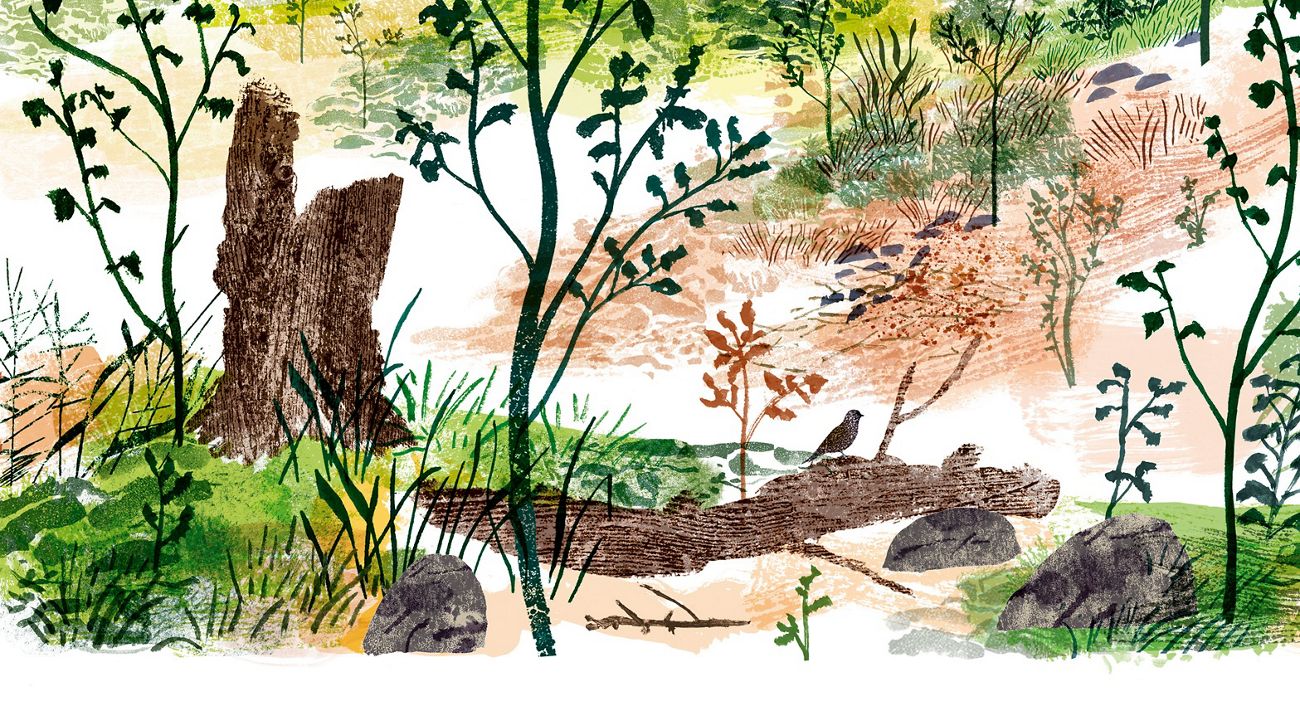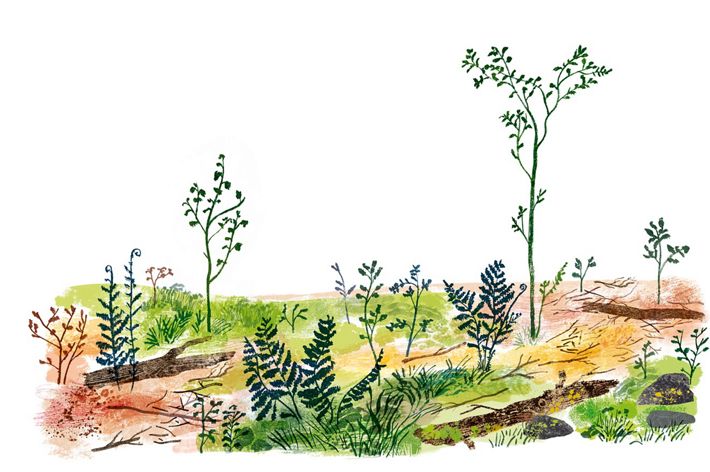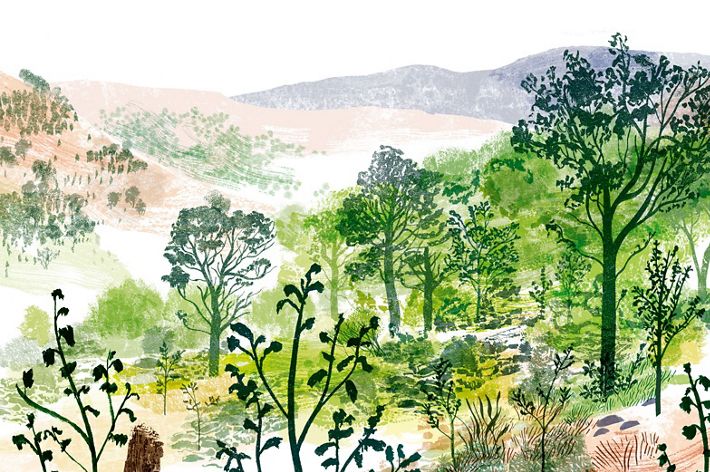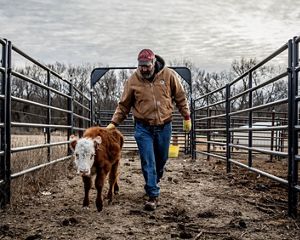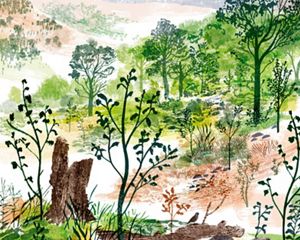Second Nature
A 2020 study suggests letting forests regrow naturally can help boost efforts to fight climate change.
Spring 2022
In 2013, scientist Susan Cook-Patton and a few other researchers with the Smithsonian Environmental Research Center began an experiment to answer a simple question: What tree-planting strategies work best? Together with a brigade of 100 citizen scientists, the researchers planted red maple and white oak, sweetgum and sour gum—some 20,000 native saplings in all—on former cropland near Chesapeake Bay. But the answer they found was unexpected.

“The trees that were growing best were ones that were coming up from rootstock and seeds that were just sort of in the soil,” says Cook-Patton, now a senior forest restora- tion scientist for The Nature Conservancy. “When people think about reforestation, their minds often go straight to tree planting. But we shouldn’t forget that trees can grow themselves.”
It’s a lesson that looms large in a study led by Cook-Patton, published in Nature in 2020, that suggests that degraded forests, left to regrow naturally, may hold more carbon storage potential than previously thought. In the process, natural reforestation may be an unsung partner in the fight against climate change—not replacing large-scale tree planting efforts, but working alongside them.
In the analysis, a team of scientists synthesized results from more than 250 studies on carbon absorption in regrowing forests. They found that these fledgling forests have the potential to absorb up to 8.9 billion metric tons of carbon dioxide every year for the next three decades, without negatively affecting native grasslands or food production. The rate of carbon accumulation used to make that estimate is 32% higher, on average, than the figures used by the Intergovernmental Panel on Climate Change. That matters because those numbers guide many nations’ commitments to lower carbon emissions. In other words, governments may not realize the value in simply leaving their degraded forests alone to grow.
Forests vary widely though. They don’t absorb carbon at the same rates, and the study delves deep into those details: It provides a world map, with a resolution of one kilometer, that allows anyone to compare the carbon potential of natural reforestation from site to site. Some young secondary forests can soak up 100 times as much carbon as others, depending on factors such as climate, rainfall, soils and elevation.
A tropical rainforest in Costa Rica or the Amazon basin will grow more quickly—and soak up more carbon—than a temperate pine forest in Maine. Even within a single region, however, there is startling variation. Take Colombia, a not-especially-large nation with a more than threefold difference in carbon accumulation rates from one tropical forest to another. “When policymakers think about where to invest in reforestation,” Cook-Patton says, “they can zero in on the hot spots.
The Potential in a Logged Field
Staring at a field left to regenerate, it can be hard to see the potential, says Robin Chazdon, a retired professor and forest ecologist who is co-author of the study. “It’s unkempt and messy. It doesn’t look like a forest right away,” she says. But don’t judge a young forest by its tree cover.
For more than two decades Chazdon studied tropical forest recovery in northeastern Costa Rica, and she watched as land degraded for grazing and logging transformed from a scruffy collection of shrubs and vines to lush tropical forest echoing with birdsong. “Seeing it recover, I gained an appreciation for the promise of letting forests regrow,” she says.
That reforestation pattern has repeated itself in degraded lands left alone in several parts of the world. In the Carpathian Mountains of Europe, for instance, farmland abandoned in the 1990s has regrown into secondary forests of beech, sycamore, alder and other species. The Atlantic Forest of Brazil has naturally regained just over 6 million acres in the last 25 years. And in the United States, the Eastern Deciduous Forest—spanning from Maine to Florida—mounted a comeback after nearly being lost.
“Here in New England,” says Laura Marx, a forest ecologist at TNC in Massachusetts, “our history is one of natural reforestation.” European colonists’ demand for timber and farmland felled most of the trees by the 1920s. But, left fallow in the intervening years, much of that forestland returned to its wild roots. Between 1930 and 2000, forest cover in the eastern United States increased from just 10% to nearly 40%. “We’re lucky that we have the right soils, and the right climate, that allowed those fields to return to forests,” she says.
Waiting for forests to heal themselves isn’t always practical, however. While some degraded forests regain much of their former glory within two or three decades, sites with poor soils, no native seed source or a glut of invasive species might never gain a foothold.
Forest Carbon 101
So how do trees soak up carbon? Ronnie Drever, a senior conservation scientist for Nature United, TNC’s Canadian affiliate, explains how in this Q &A—and why they’re such a key part of TNC’s climate strategy.
Helping Nature Along
Even when regrowth is a viable option, forests often can benefit from a little help. In the eastern United States, the fastest-growing trees can sometimes outcompete slower species, creating a less diverse secondary forest than the old-growth that was lost. But conservationists can give regrowth a helping hand by protecting land from disturbance, removing non-native species or planning controlled burns, for instance, to maintain diversity and reduce the wildfire hazards.
Such “assisted natural regeneration” is taking place in the Greater Mahale Ecosystem of western Tanzania, where TNC is working with local villages to find alternatives to grazing cattle in areas where secondary forests are beginning to grow. “By stopping grazing, we can allow natural regeneration to occur,” says Kevin Juma, TNC’s Africa forest carbon catalyst director. “Where it is suitable, it’s the most cost-effective way to restore forests.”
Letting forests rewild themselves is both cheaper and easier than planting thousands of seeds or saplings. But cost isn’t the only benefit. Natural regrowth can encourage a more diverse forest to grow than the monoculture that sometimes results from industrial forestry or large-scale plantings. “Encouraging natural regrowth in areas where it’s suitable can provide natural corridors between mature forests,” says Chazdon. “Many animals are willing to walk or fly through the understory of a secondary forest, while they’re not willing to travel through a tree plantation.”
On the East Coast, where forest cover has begun declining again, the forest ecologist Marx and her colleagues are now considering where and how natural reforestation might fit into their modern conservation efforts. One option could be a “pay for performance” incentive to reward landowners who recover a certain amount of tree density, even if they never plant a single seed or sapling. “Whether they get there by planting trees, or because they stopped mowing, or put up fences to keep out deer, in some ways it doesn’t matter,” Marx says. “We want to encourage people to use whatever methods are most likely to be successful at achieving reforestation.”
In the end that is the point: a green, growing forest, whether planted or naturally regenerated. As Peter Ellis, TNC’s global director of climate science and a co-author of Cook-Patton’s study, puts it: “We already have this amazing machine, invented by nature, that takes carbon dioxide and turns it into wood. Let’s find those places that aren’t being put to their best use and let them regrow, so they can capture as much carbon as possible.”
